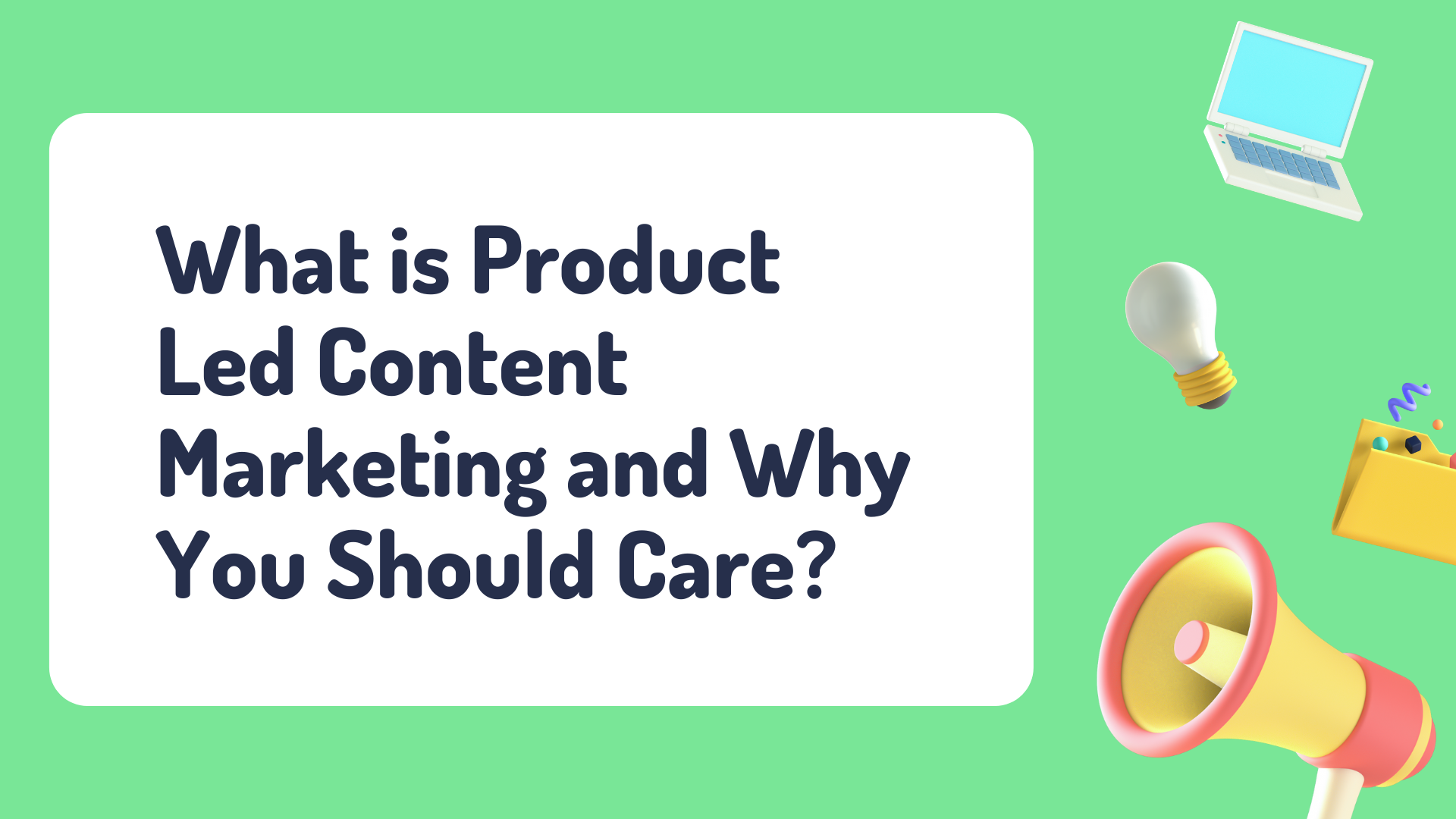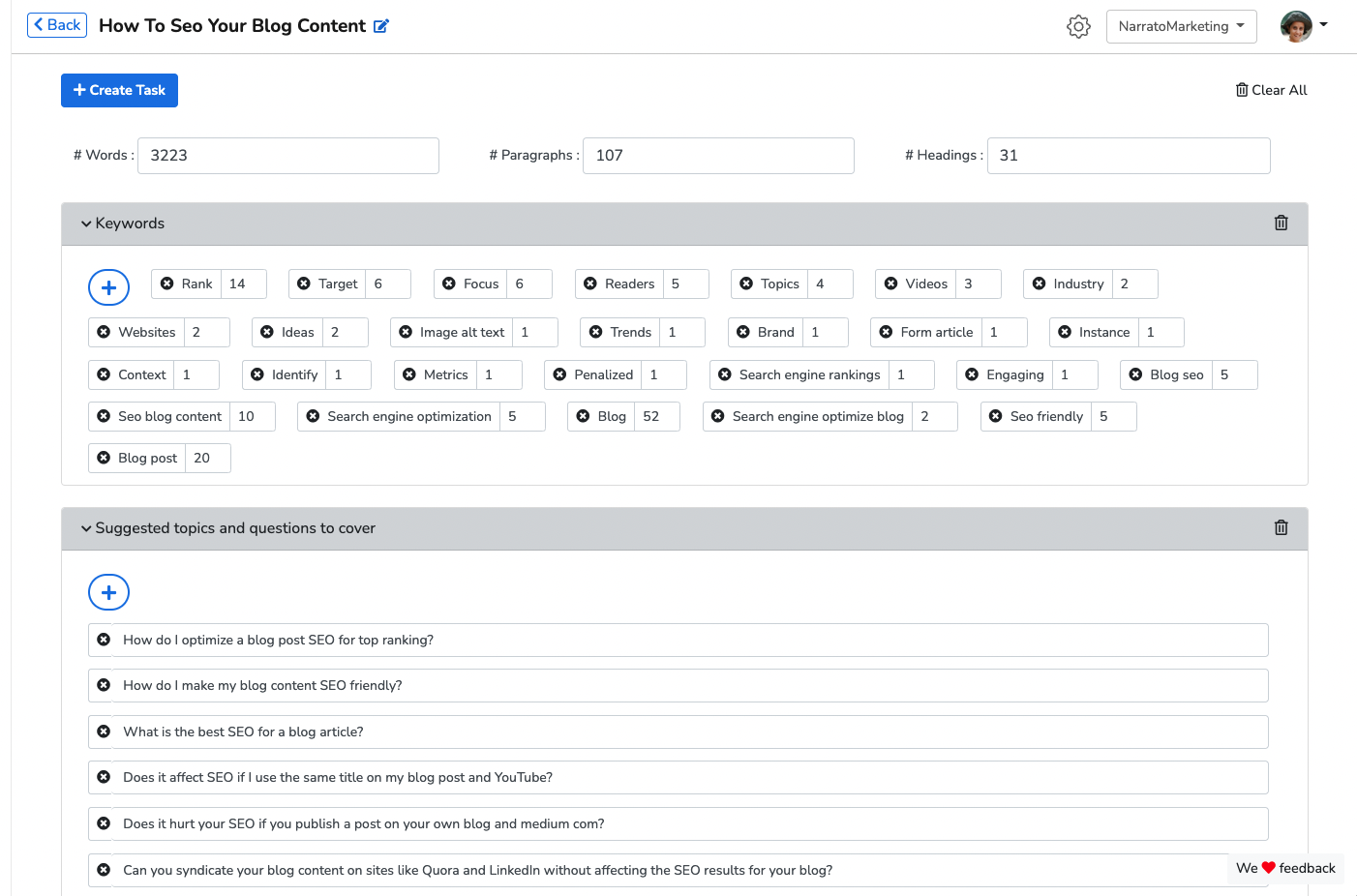Quite often, you will find a blog or an e-book that offers just the right answers you’ve been looking for. But it takes you some digging up to find that the company publishing such immensely useful content itself has a product that could solve all your problems. By that time, though, you probably discovered and settled for some other similar product. What does the company offering such helpful information and know-how get in return? Nothing more than a little goodwill maybe. But they’ve lost a solid deal at hand, all because they failed to drive product-led growth with their content. If you haven’t been leveraging product-led content marketing, you could be losing such valuable conversions too.
When we talk of content in product marketing today, it is no longer limited to landing pages or your website’s feature page. You cannot wait for a potential customer to land up on your website and discover your product. In fact, Trust Radius reveals in its 2021 B2B Buying Disconnect Report that most B2B buyers find vendor websites and representatives to be less trustworthy information sources for their purchase decisions.
You need to catch them early on in the customer journey and tell them what you could do for them, in the most subtle, unbiased way you can. Businesses have to find ways to weave their product as a solution into their other marketing collaterals, building awareness while answering a potential customer’s burning questions. That is product-led content marketing which marketers, especially in SaaS companies, swear by today.
Let’s get started with some key concepts:
- What is product-led growth?
- What is product-led content?
- What is product-led storytelling?
- What is the role of content marketing in product-led growth strategy?
- How has content marketing changed with product-led growth?
- What are the main benefits of product-led content marketing?
- Examples of successful SaaS companies using product-led content marketing

What is product-led growth?
Product-led growth or PLG strategy refers to a business model in which the product itself drives user acquisition, conversions, and customer retention. The product is considered the primary driver of sustainable and scalable growth. In a product-led growth strategy, collaboration across different teams including marketing, product, sales, and customer success is necessary to build a great customer experience right from the beginning of the customer journey.
Product-led marketing is being seen as the next big Go-to-Market (GTM) strategy for SaaS companies and startups in particular, as it allows the product to speak for itself and build brand awareness. Whether you look at the Notion content marketing strategy, ClickUp or any other, product-led content is front and center in them all. According to McKinsey’s research on B2B sales, 70 to 80% of B2B decision-makers today prefer digital self-service over in-person interactions with sales reps. And what better way to enable self-service than by providing them with content that puts the product at the forefront.
TL;DR Here’s a quick summary video of this article.
What is product-led content?
Product-led content is content where the product is very skillfully woven into the narrative. In product-led content, the product is used to demonstrate a solution or illustrate a point you just made. It should not be blatantly promotional or salesy, like a paid ad. Rather, as a part of the narrative, the product should help the audience visualize the solution you are talking about, while they also discover that you have just the right tool for it.
Product-led content still has to be valuable to the audience, addressing their problems and offering insights and information. It does not have to include a strong CTA every time, as the purpose here is not to hard sell the product. The audience will learn about the product through the content on their own and, if you’ve done it justice, they will be encouraged to explore it further.
What is product-led storytelling?
Product-led storytelling is the art of writing discoverable stories around your product that your audience can relate to. Since product-led content is not meant to be promotional, storytelling plays a very crucial role here. You could use product-led storytelling in a case study on how someone overcame a particular challenge using your product. Or simply write a how-to article where you start by describing a problem the audience may be facing and then effortlessly guide them to a solution that involves using your product. Irrespective of what content it is, product-led storytelling has to reflect empathy and an understanding of your audience’s challenges.
In an article by Leadfeeder, the author shares excerpts from an interview with Ahrefs CMO, Tim Suolo. Tim states that he often received emails from customers signing up for Ahrefs, saying that they read a particular article and loved how they’re using the product for these cases and that’s what made them sign up. This made Tim realize that people don’t sign up for a product and then learn how to use it. Rather, they learn how to use it to solve a problem and then sign up because it gives them confidence.
That is what product-led storytelling does for your business. Give your audience a story they can relate to or create a scenario they can imagine themselves in, very discreetly portray your product as a tool for success – and they will probably end up becoming a customer.
TL;DR – Here’s a quick video on all the key concepts discussed in this blog post.
https://www.youtube.com/watch?v=tXZQdOJWdpE&t=1s
What is the role of content marketing in product-led growth strategy?
Product-led content marketing plays a central role in product-led growth. Using product-led content as a marketing tool allows you to portray your product as an ideal solution to the audience’s pain points. Product-led content marketing, particularly for a SaaS company, is a great opportunity to show their potential customers how to use the product, what applications it might have or how easily a problem can be solved using the product.
Product-led content marketing is very much like advertising, but not quite. In an ad, you would highlight your product’s most valuable features and probably show what is unique to it by showing product usage. In product-led marketing too, you’re demonstrating product usage, but more so with a customer-centric approach.
Unlike in advertising, the product is not the main focus of your content. The customer’s pain point is. The product is only there as a possible solution.
In an ad, you’d probably be saying – ‘Use this product. It has these features that no other product in this category has.’ But in product-led content marketing, you’re rather saying – ‘This is your problem. This is how you should approach and solve it. And here’s an example of how this product can help you implement the solution’.
For instance, in this Ahrefs (who are masters of product-led marketing, btw) blog post on Keyword Research, you will notice how they recommend using their site explorer tool for finding keyword ideas.
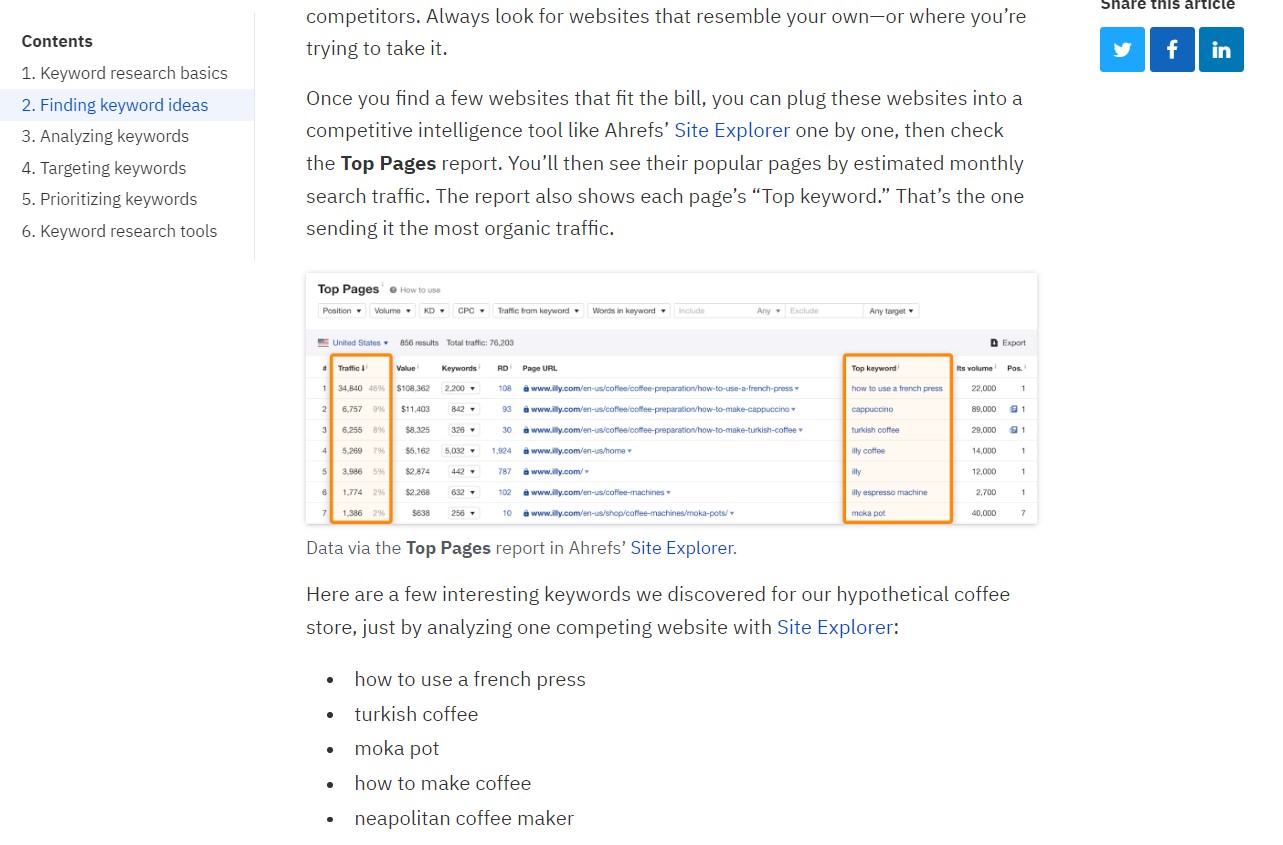
It does not say that Ahrefs offers the only solution or even the best solution, but it still demonstrates how you can use the tool and what outcomes you could achieve with it.
Here’s another example. Say we at Narrato are writing a piece on how to boost SEO in your blog content. The purpose of this article would primarily be to help our audience thoroughly understand the importance of SEO and how they can ensure that their writers optimize their content for search.
But we can actually add more value to the article by showing you how to leverage content marketing automation tools and generate an automated SEO content brief on Narrato. For boosting SEO, you need the right keywords and subheadings to include, the ideal length of a blog post, competitors to benchmark against, and similar insights. Narrato’s SEO content brief can provide with all of these. Showing you how we do it on Narrato along with a simple screenshot like the one below, is a great way to add substance to the post.
Your audience expects you to offer helpful advice through content and your goal is to build brand awareness and establish your authority in the niche. A product-led content marketing strategy helps you achieve both.
Where does product-led content fit in a holistic content marketing plan?
Despite the many pros of product-led content, it should not be your only marketing strategy because at some point it can become monotonous and quite obvious to your audience. But it should definitely be an integral part of your overall content marketing strategy.
You could implement a product-led approach in your content marketing plan for different channels from time to time. From creating authoritative blog posts to instructional videos to engaging podcasts, various product-led content types can easily be accommodated in your content marketing plan without overindulging.
How has content marketing changed with product-led growth?
The most evident change that you would witness in content marketing focused on product-led growth is the involvement of multiple business functions in the content process. Usually, content marketing is seen as the sole responsibility of the marketing team with occasional inputs from sales or customer success.
But with product-led content marketing, you will need dedicated involvement of marketing, sales, customer success, engineering, and design teams. Collaboration between so many different areas of a business to create content that delivers real value can be challenging to say the least. Gathering inputs across teams, creating content, getting feedback and approval – all of this invariably makes the process more complex.
To manage your content creation process with a product-led approach, you will need to enable better collaboration for your content team. A good content collaboration platform is a must-have in this case. We have been creating content in consultation with our product and tech teams for a while now using Narrato, and have realized how much easier it is to collaborate on a single platform than having to go back and forth over docs, emails, and chats. We have added all our team members as users in different roles on the platform, giving them custom access to content projects as necessary.
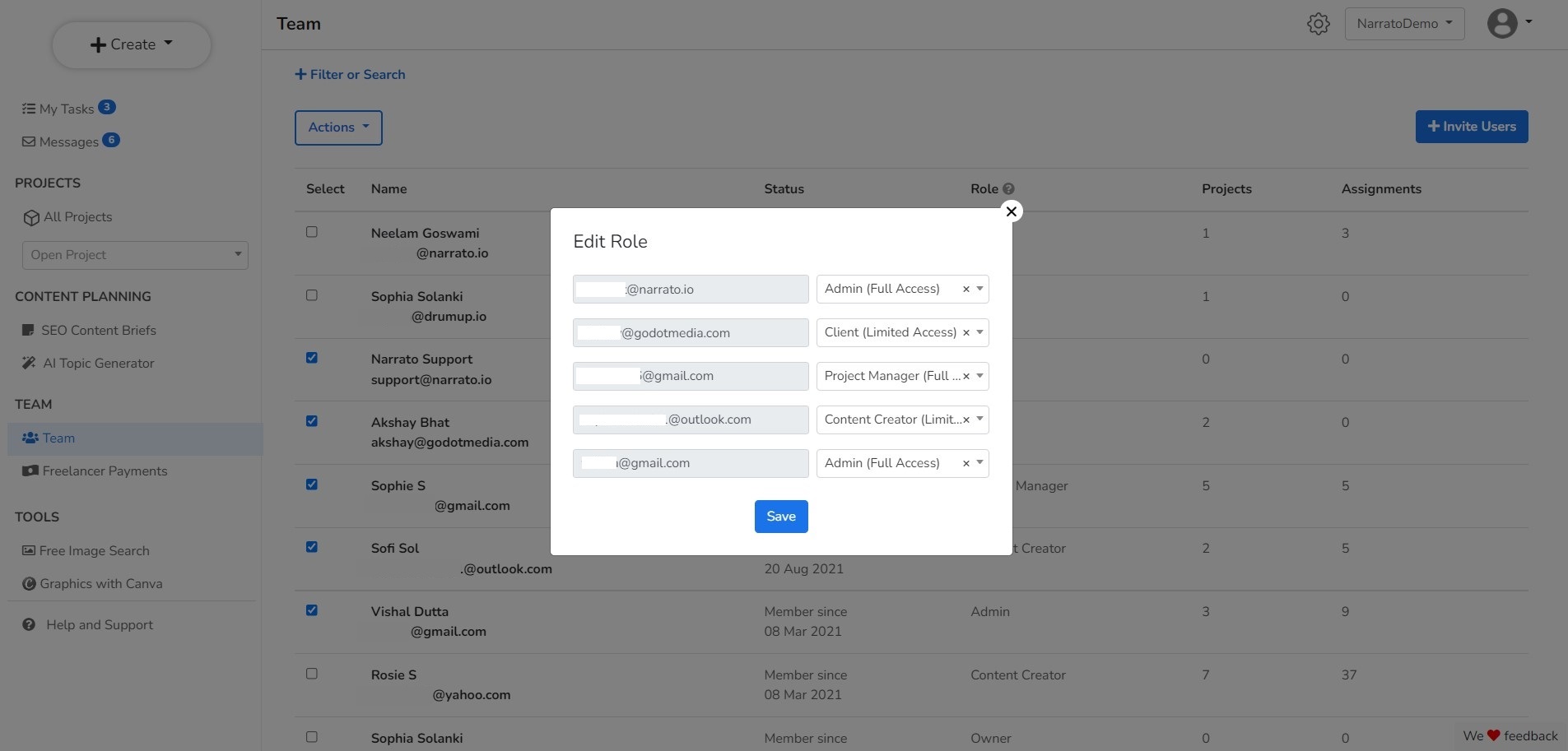
They can comment on content tasks and send messages on the platform itself, making our product-led marketing efforts sail much more smoothly.
So, when you are investing in product-led content marketing, you will also need to make some changes to your marketing tool stack by adding more content marketing automation and collaboration tools.

What are the main benefits of product-led content marketing?
There are several benefits of product-led content marketing both for the success of your campaigns and the success of your business as a whole.
Inexpensive and impactful way of user acquisition
As compared to advertising your product using paid media, product-led content marketing is far more cost-effective. You are not only generating brand awareness by weaving the product into your content, but also gradually building trust and increasing your chances of word-of-mouth marketing. This can be extremely helpful for SaaS startups looking to spread the word about a solid product they offer.
When your audience sees the product in action, as part of valuable content and not a paid ad, it is bound to generate more interest and can also drive traffic to your product website. So, a product-led growth strategy in content marketing could bring down your user acquisition costs, if done right. All you will need is to invest in some powerful but affordable content marketing automation software.
Targets potential customers at all stages of the sales funnel
Product-led content marketing does not only target customers who are ready to buy. You can actually create product-led content for everyone starting from top-of-funnel to bottom-of-funnel. By providing value at each stage of a customer’s journey you are also enhancing the customer experience.
You can create broad content to satisfy the search intent of potential customers still in the awareness stage. For instance, the Ahrefs article ‘What Are Keywords? How to Use Them for SEO‘ is a perfect example of TOFU product-led content for anyone doing a general search on SEO or keyword optimization. It familiarizes the audience very subtly with the tool, enabling discovery.
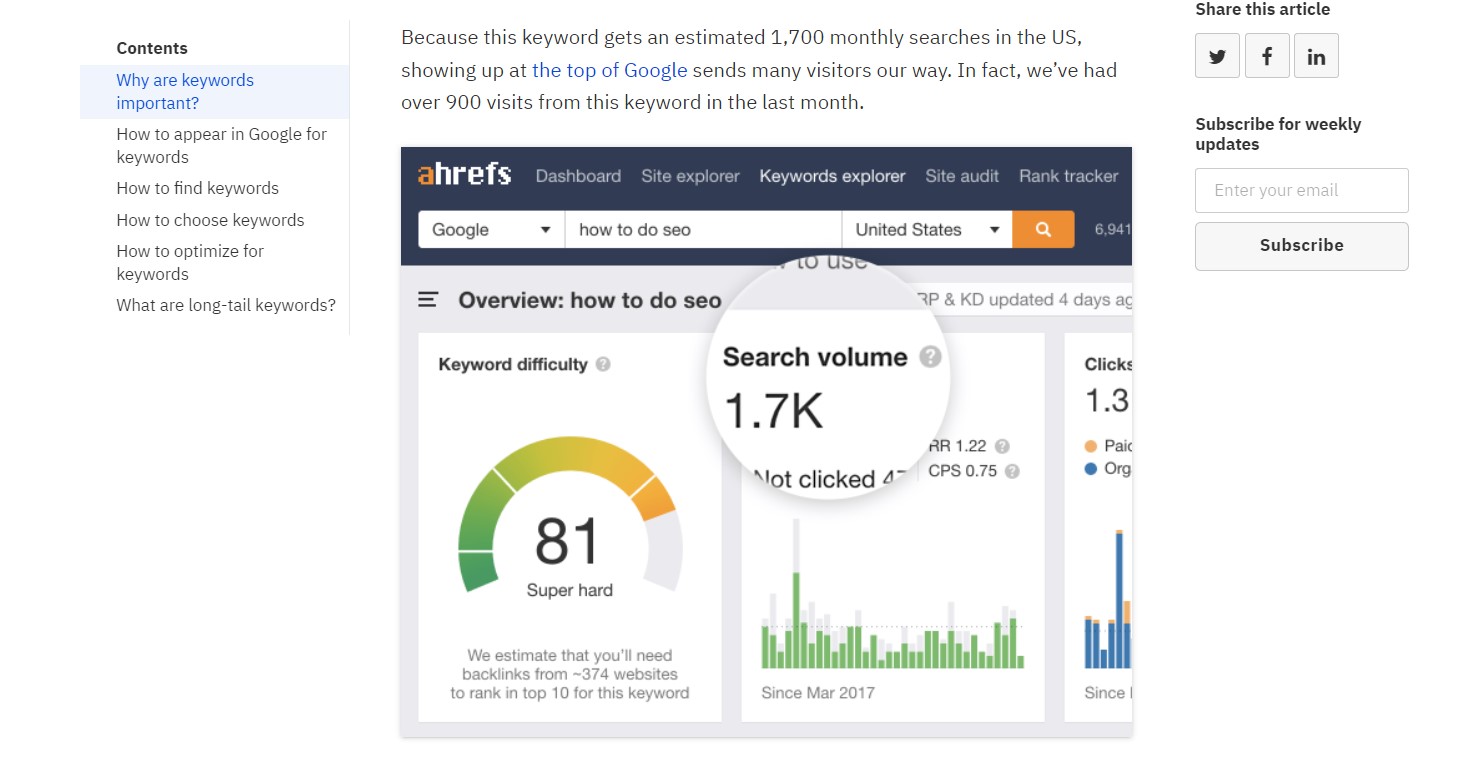
Whereas another blog post on ‘10 Free Keyword Research Tools (That Aren’t Google Keyword Planner)‘ that also lists Ahrefs as an option, is for someone who is actively looking to buy a keyword research tool. This is their BOFU product-led content that is targeted at potential customers in the decision stage of the customer journey.
Supports customer retention
One of the biggest challenges faced by SaaS companies is not always user acquisition but rather customer retention. If you fail to deliver the same value you did when onboarding a customer, they are likely to switch to other options in the market because there are many. Product-led content marketing prevents this by helping existing customers discover new ways of using your product too.
For instance, consider creating a knowledge base for your audience where they can find out about new feature additions to your product and how to use them. Help and support content like this, triggered at the right time during a customer’s journey using marketing automation, can significantly increase the chances of new feature discovery by existing customers.This could involve sending triggered emails recommending the help content based on a customer’s activity, or a pop-up on your blog/website that appears when a customer views certain content. By offering help at the right time, you are more likely keep them on your platform for longer and help them find more valuable product-led content.
So product-led content marketing does not only help you capture potential customers but also keep the existing ones happy.
Leaves a lasting impression of your product on the audience’s minds
If you’ve done some really good product-led storytelling, it is likely that your audience will remember your product for much longer than what they see in a paid ad. By incorporating a product seamlessly into some actionable and useful content, you can leave a lasting impression. Whenever a user is reminded of what they learned from the content they will associate it with the points you illustrated with your product and may even be interested in trying it out.
Examples of successful SaaS companies using product-led content marketing
Though product-led content marketing is relatively new and most SaaS companies are still getting warmed up to the idea as their GTM strategy, there are some brands that have been using this tactic successfully for a while.
Here are a few examples of brands that have mastered product-led content and can be a good place to start your research.
HubSpot
We wouldn’t be wrong if we called HubSpot the industry leader when it comes to content marketing. And they have been using product-led content in the HubSpot content marketing strategy even before many of us were familiar with the term. HubSpot has always found a way to sneak in a word or two about their product in almost every piece of content they create. But in doing so, the product placement never seems out of place or forced. That is what product-led content is all about.
Here’s an example of a HubSpot blog post on how to use a CRM.

Ahrefs
We’ve already referenced Ahrefs a few times in this post, so that makes it obvious that the company is a force to reckon with in the product-led content domain. Almost every blog post on the Ahrefs blog is a product-led piece that demonstrates their product usage in one way or another.
Here’s an example of an Ahrefs post on digital marketing strategies, where they have yet again managed to weave their SEO tool into the content at the very beginning and pulled it off like pros.
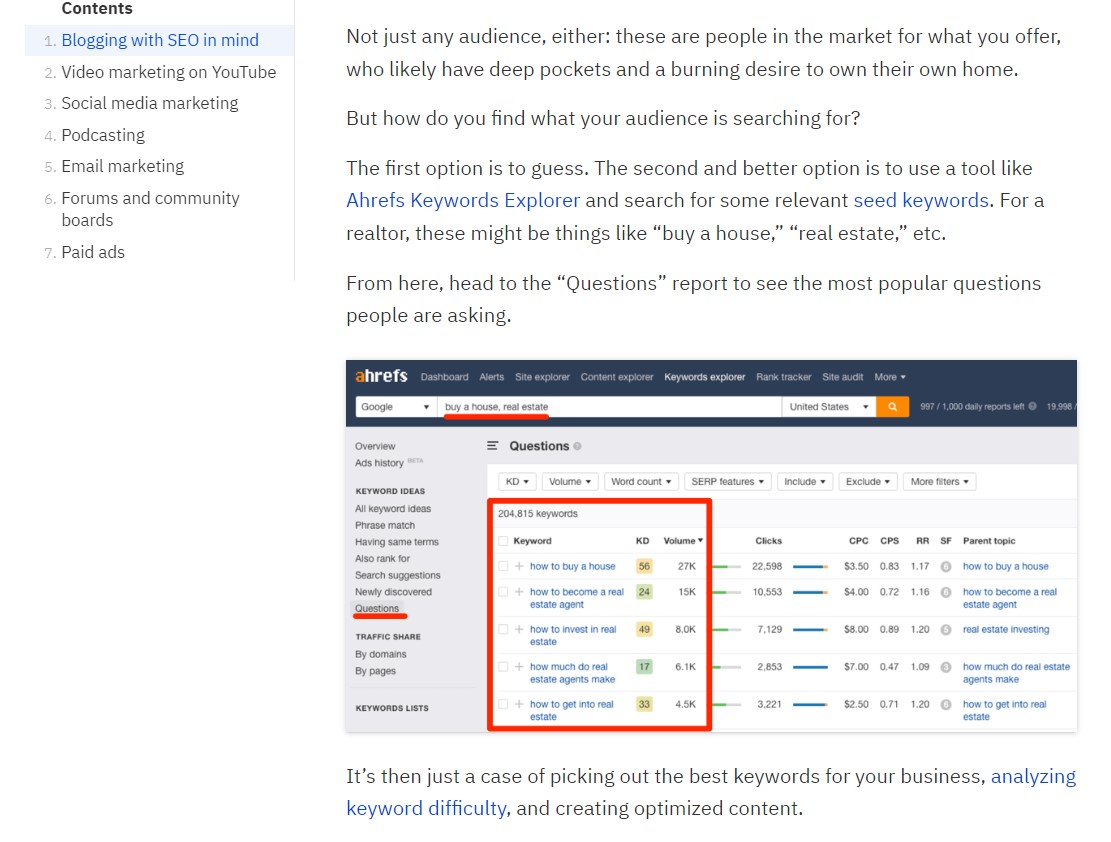
Slack
Slack is a communication and collaboration platform, perfect for remote teams. And the company ensures that they make the best of this use case by writing a lot of articles on remote collaboration. They either include a user testimonial on how they use Slack for their daily communication in between some actionable tips on boosting productivity. Or they run a full-blown case study on how a client is using Slack for nurturing team culture in a remote setting.
In this example, Collaborate with kindness: Consider these etiquette tips in Slack, the SaaS company actually targets its existing users giving them a few nuggets of wisdom on how to make more ethical use of the platform. This is the kind of customer retention focused product-led content we were talking about earlier.

ClickUp
ClickUp is another SaaS company that has succeeded at product-led content marketing as a GTM strategy. Apart from the Product category on their blog where they discuss use cases, share case studies and uncover new features, they share insightful pieces on various topics relevant to their audience personas. But they make sure to introduce ClickUp as a solution for all of these cases.
This is an article on the ClickUp blog that talks about Agile Epics. You can see how they’ve slipped in ClickUp as a goal-tracking tool to use for the very first step in creating an Agile Epic.
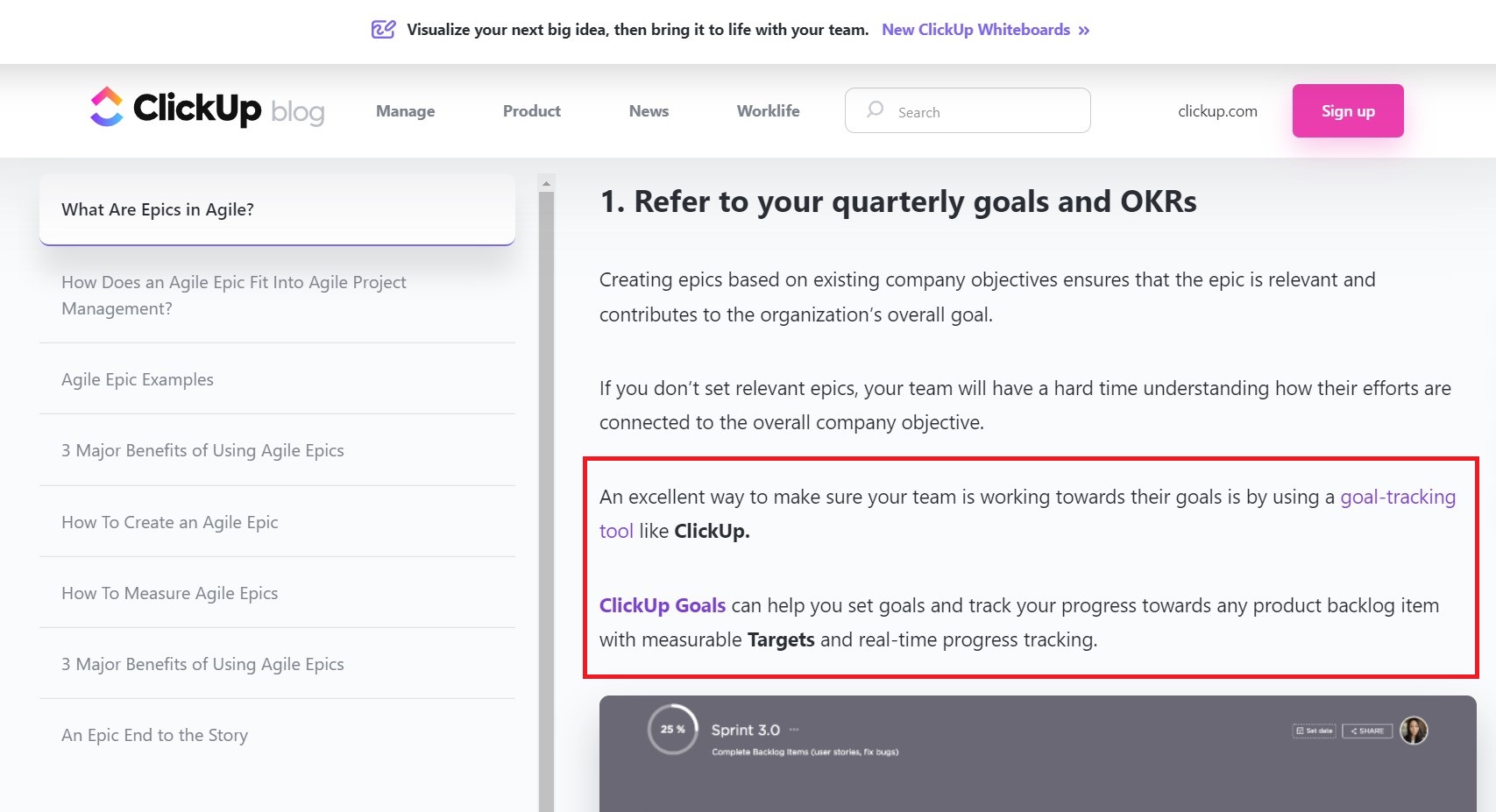
If you want to learn a little more about the role of product-led content in SaaS marketing, check out our ClickUp content marketing case study.
Conclusion
Product-led content marketing is the present and future of marketing-led growth. Brands that have adopted this smart strategy are seeing great results and those that haven’t, are preparing to jump on the bandwagon as well. If you haven’t started planning already, it is high time to get your product, marketing, and other teams together. Brainstorm and list ideas on how you can tie your product to your content organically, ensuring it is seen and remembered. Also, keep following this space because we will be sharing a lot more on PLG strategy and product-led content in the near future.


